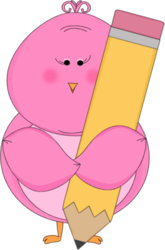Amanda Miller
Page Navigation
-

Super Spellers!
-
Strategies for Improving Spelling
Spelling in English requires a lot of memorization. English is a language that has a large number of phonemes. With only 26 letters, English must represent at least 55 phonemes or categories of sounds.
Why do children need to learn to spell correctly?
· It's the first thing a reader notices.
· Anxiety about spelling inhibits a child's writing.
To improve and develop spelling, children need to:
· Develop an interest in words.
· Feel safe about trying new words.
· Learn about the way words are built up using syllables.
· Learn about the basic spelling patterns of English.
· Learn about memorizing strategies.
· Learn about the meanings of words.
· Learn about prefixes and suffixes.
· Write for their own enjoyment, without the fear that they will be criticized.
· Read for pleasure.
Parents can help their children by:
· Encouraging them to look closely at words, and talking to them about words.
· Encouraging them to try new words (they won't do this if you are always criticizing their spelling).
· Playing word games with them such as Hangman, Boggle, Scrabble, and other word games.
· Encouraging effective memorizing strategies.
· Encouraging spare time reading, including visits to the library.
· Providing a dictionary for them to use.
A useful strategy for memorizing new words:
· When you come across a new word ALWAYS use the LOOK-THINK-COVER-WRITE-CHECK method to memorize it.
· LOOK carefully at the new word. How can you break it into smaller bits? Do any of the smaller bits remind you of the patterns of letters from other words?
· THINK about the parts of the words, which might cause problems-double letters, for example, or a vowel that isn't pronounced as you would expect.
· COVER the word and close your eyes. Try to see it in your mind's eye.
· WRITE the word down without looking back.
· CHECK to see if you're right. If not, look carefully at where you went wrong and try again.
· Try "finger writing"-while you're thinking about the word, pretend to write it with your finger, on your desk, or your hand.
Other information you may find helpful:
· Word Families: These are words based on a single phonogram such as pink, link, shrink, think. English has hundreds of phonograms from which hundreds of word families can be taught. Dr. Seuss's books such as The Cat in the Hat are based on word families. That is why they are so easy to read and memorize.
· Spelling Patterns: We teach spelling patterns of words to help students be able to read and spell.
Ex. VCCV-vowel, consonant, consonant, vowel.
CVCe-consonant, vowel, consonant, silent e:
The vowel usually makes the long sound.
Sources:

